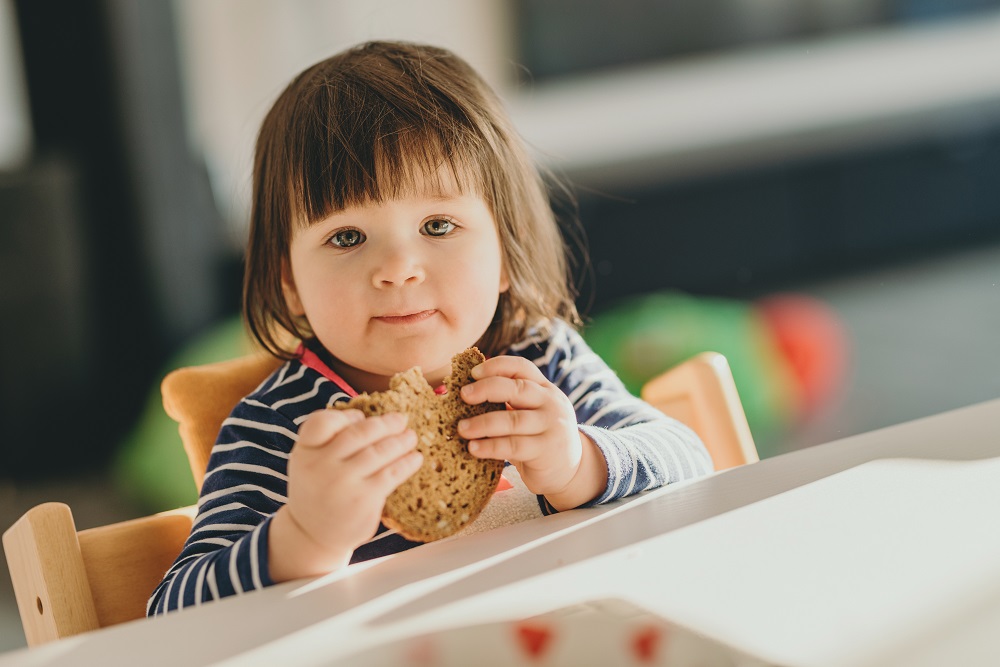Snacks keep kids going between meals
Is baby fussy and wiggly in the middle of the afternoon? It’s probably time for a snack. Whether it’s salty or sweet, a snack is the best way to keep your child going until the next meal.
Why do kids need snacks?
To grow up healthy, your child needs a lot of energy. That means 3 meals a day… plus snacks! Because kids have small stomachs, they need to eat often. Snacks give your child enough energy and keep them from feeling hungry until the next meal.
The best snack time
Kids have small stomachs but big energy needs! So your child should eat about every 3 hours. Even if your child ate a lot at the last meal, they still need to refuel often. It’s normal for kids to be hungry between meals. And that’s where snacks come in.
The ideal is to give a snack 2 hours before the next meal, so your child will still eat the next meal. If your child is very hungry and the meal isn’t quite ready yet, offer some veggies or crackers to appease their hunger until the meal.
Avoid giving rich foods (like cheese) or sweet foods (like cookies or muffins) because these will spoil the child’s appetite for the meal.
Depending on what time you have your meals, here’s what a snack schedule could look like for a day:
- Breakfast: When baby wakes up, around 7 a.m.
- Morning snack: Around 9:30 or 10 a.m.
- Lunch: Around noon
- Afternoon snack: After the afternoon nap, around 3 p.m.
- Dinner: Between 5 and 6 p.m.
- Evening snack: Optional; around 7 p.m., depending on what time dinner and bedtime are
If supper is more than 2 hours before bedtime and your child is hungry, it’s better to offer some food before bed. A light snack, like a bowl of cereal with milk, should keep them satisfied and help them sleep better.

Keep snack time calm
Like at mealtimes, it’s important for your child to be aware of his or her needs at snack time. That’s a good habit that helps baby eat well and prevents overeating.
Here are a few tips:
- Ask your child to sit down to eat the snack.
- Choose a calm location, without any toys nearby, like the kitchen or dining room.
- Avoid giving your child snacks while in the car because that increases the risk of choking.
Snack time is a break from playing to fuel up!
The recipe for a great snack
What should you offer as a snack? It’s simple! The ideal snack combines 2 foods.
For example:
- Fruit added into yogourt
- Apple slices with cheese
- Pita bread with hummus
Download our tool for ideas on how to create a perfect snack!

The role of snacks in balanced eating
Snacks also offer kids an extra chance to get the vitamins and minerals they need. Sometimes, your child may eat very little at a meal. Or it can happen that one meal isn’t very balanced. That’s all normal. Then, you can use the snack to round out the day’s meals.
For example, if your child didn’t want vegetables at lunchtime, offer cucumber pieces or applesauce with cheese at snack time to increase their intake of fruit and vegetables for the day.
Snacks complement meals. They don’t replace meals and should not be seen as a reward.

Avoid giving treats (chocolate, candy, chips, etc.) as snacks. Of course, you can have an ice cream snack once in a while, but try not to make it a habit. Choose nutritious foods most often.
Do you like cooking? Introduce your child to it by letting them help make snacks, like Apple-Carrot Bread or Banana-Cranberry Muffins.
And don’t forget to pack a snack when you go out! 🙂
Writing : Fondation Olo
Scientific review : Mylène Duplessis Brochu, nutritionist, Dt.P., M.Sc.
